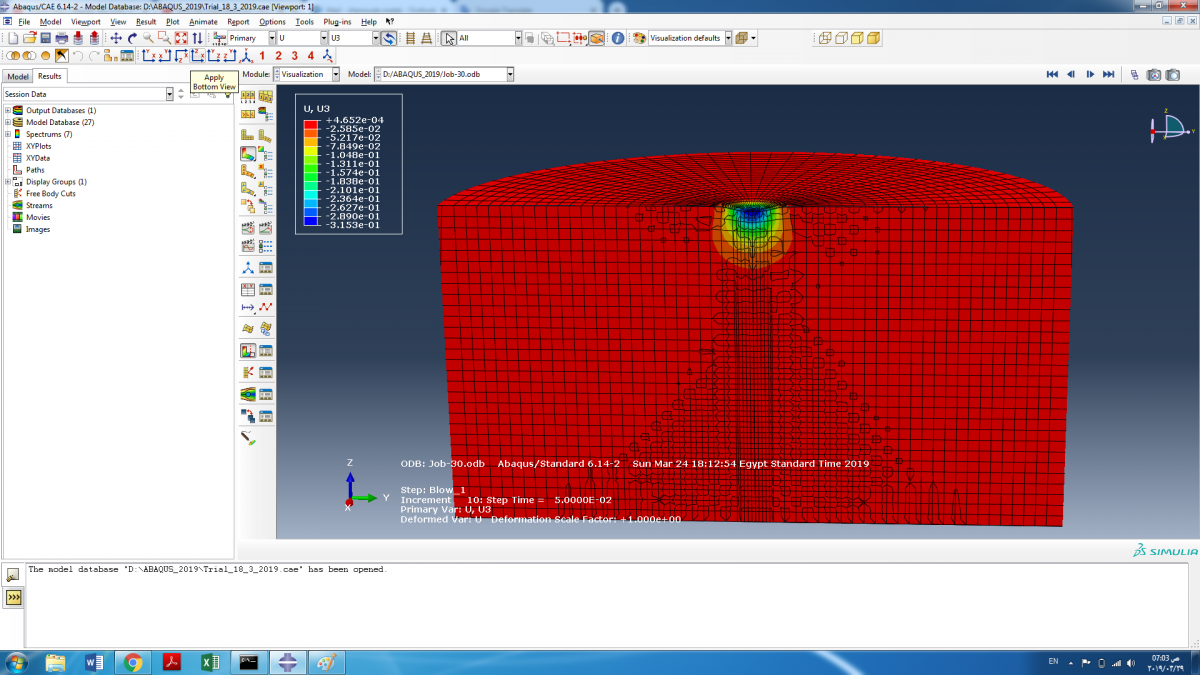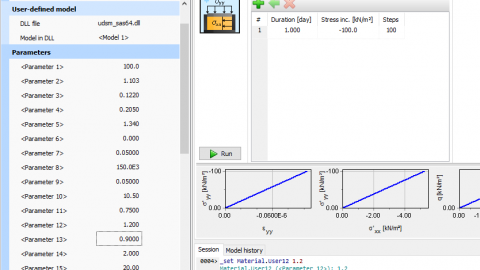Hi all,
After successfully testing a linear elastic Umat on Abaqus, I am now trying to test the Hypoplastic model Umat. I intend to carry out a drained triaxial single element tests and reproduce the results from Dr. Masin PhD [ table 4.6 and figure 4.9 (b) ].
1. Are there other simple test results for me to back analyse to check whether I am using the UMAT correctly?
2. Is parameter 18 responsible for whether a 2D or 3D analysis is being perfomed? Also unsure if there are any restrictions to using the UMAT for certain type of elements/analysis (eg. axisymmetric).
Thank you and looking forward to hear useful responses.
Hashmi
Tags: UMAT ABAQUS Hypoplasticity Clay




Dear Hashmi,
– To check, you can run equivalent tests in soilmodels.com/excalibre or soilmodels.com/triax.
– Par18 is there only when anistropy is adopted – it then needs to know direction normal to bedding planes. It does not have anything in common with 2D/3D. The same model is used in 2D and 3D, nothing special is specified.
Regards David
Hi David,
Thank you for these information. I got the files for TRIAX and I am familiarising myself with the software/input which is rather straight forward.
Can you please also advise on the following:
1. is the default Laboratory Test Simulation on ExCalibre solely for drained tests?
2. is there a more up-to-date triax manual that includes hypoplasti_clay_explicit?
Thank you for confirming that nothing has to be input in the Hypoplastic Clay UMAT for it to be compatible with a specific type of analysis (2D or 3D, stress or strain controlled) or type of elements. In the guide that I have, it mentioned to set parameter 18 to 2 in PLaxis 2D and thus I wrongly inferred that it relates to whether the analysis is 2D or 3D. As you said, it is only indicating where vertical is in the model.
Cheers,
Hashmi
1. No, you can select Ciup (undrained) or Cid (drained)
2. No. You still can run triax and read the required parameters order at the screen of cmd window (if you run just be clicking at the exe file, go to “cmd” and run b typing triax – then you will see the message)
Ok thanks, I will post my results when I have performed the single element test using the Hypoplastic UMAT on Abaqus and compared with Traix.
Hi again,
I wanted to try to compare the prediction (q vs ea and ev vs ea) of a drained single element test using the MCC model and basic hypoplasticity. Are there empirical equations that link lamda to lamda-star and the same for kappa?
Thanks.
Hi Hashmi,
Actually, as these are defined in different spaces (e vs ln(1+e)), there is no direct relationship. You can only select stress range of your interest and approximate one curve with the other in a way you choose (by fitting the maximum/minimum points, least square method, etc.). As there is this ambiguity, transformations are not provided in the software, you need to work it out yourself in a spreadhseet.
Regards David
Hi David,
Thank you for the advices. Yes, I suppose that the best thing to do is to create a v – lnp’ using lamda, N and kappa for MCC and then plot the equivalent ln v – ln p’ graph to find approximate equivalent star parameters.
Also, out of curiosity, what does the 5th paramter “inic. his. var” mean in triax hypoplastic model? I understand, it wants initial void ratio as parameter. (something history variable?)
Cheers,
Hashmi
I meant 6th input parameter, not 5th which is r.
Also, is there a way to request excess pwp as output when using triax_undrained using hypoplastic_clay?
Hi Hasmi
– inic. his. var is the list of initial values of state variables, one by one, which is model specific. For a particular model, run any input file with this model and you can read required order of state variables on the screen.
– excess pwp: No, all stresses are effective. Any excess pwp is subtracted from total stresses so you can only see effective stresses in triax input/output. To, for example, print excess pwp in undrained triaxial test, use sig_rad’ minus sig_rad_initial’.
Thank you very much David.